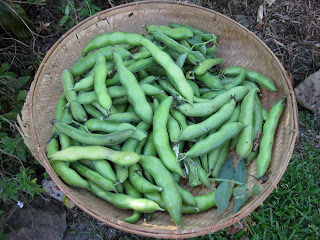Fresh salmon quiche with dill and spring onions (or chives/baby leeks). You need about 300 g of skinned, cubed fresh salmon. For a quiche this large (30 cm) you need 9 eggs instead of 6.
THE PASTRY: If you have a food processor you can make up quantities of this pastry to keep in the freezer. I use a simple recipe that I previously posted for Sorrel Tart. This is double that recipe. Half for now and half for later.
300 g chilled unsalted butter
400 g plain flour (half/half wholemeal and white)
3 tbs full cream Greek yoghurt
1 small tsp sea salt.
NOTE: Don't be afraid of making pastry - it's so versatile and so much better than the frozen supermarket stuff. You can use this pastry recipe for sweet or savoury dishes. All you need is a food processor!
Whaz the butter and flour together then add the yoghurt and pulse until it forms one clump. Divide in half for two pastry cases - store one half in the freezer for another time.
Let the other half rest in the fridge (covering first in cling film) for about 20 mins - it then become rollable - important if the weather is slightly warm, otherwise it will just fall apart.
TOP TIP: Put it in the fridge in a round flat shape with smooth edges - ready to toll out. If you just bung it in lump it is much harder to roll out later. I learned the hard way!
Baking blind!
Roll out and line a fluted quiche dish. You now have to bake it blind - cooking the pastry case without it rising. If you don't do this and put the eggy filling in straight away - the pastry at the bottom will be soggy - and we don't want that!Line the pastry with non-stick baking paper and weigh down with pasta or beans - you can re-use this.
TOP TIPS: Don't use foil, it sticks to the pastry. Have enough baking paper to make 'handles' so you can easily lift out you 'weights'.
Place in the oven on 180oC for 10 mins. Then take out the baking paper with beans - or whatever you have used to weigh it down - pop back in the oven for a further 5 mins.
It is now ready for the quiche filling.
NOTE: If this pastry case is going to be used as a sweet flan - i.e. with no further cooking - you will have to cook it for a bit longer, 15 minutes with the weights in and 10 without.
Let the fun begin! You can just about use anything you have, plus six beaten eggs.
Suggested combinations:
- Chopped fresh herbs - parsley, chives, tarragon, dill and basil with feta and topped with thinly diced tomato. I just use whatever I have in the garden.
- Ham, tomatoes, grated cheddar and parsley.
- Sauteed mushrooms and red onions with creme fraiche.
- Sliced fresh salmon with dill and spring onions.
- Roasted vegetables with sauteed onion and feta or goats cheese.
- Cooked, mashed pumpkin with sage leaves that you have fried in butter, sprinkled with pinenuts.

This is a 25cm dish. - Roast capsicum with ricotta, nutmeg and marjoram.
- Smoked salmon with some steamed broccoli and chives.
- I made this one with a bit of left-over ham and grilled capsicum, baby leeks, parsley, ruby chard and dill from the garden.
Now, you lightly whisk the 6 eggs. Add some salt and pepper - and a dash of cream if you have it, NOT MILK please - it makes the eggs go rubbery. Pour over the filling
Bake for about 20-30 mins in a pre-heated oven on 180oC until filling is firm and golden.
Delicious cold - if there's any left!
This is really one of my favourite things - and great for lunch or a picnic - I eat it for breakfast!
"A recipe should be a tune that you can sing your own song to."Chef Rick Stein on his French Odyssey
























